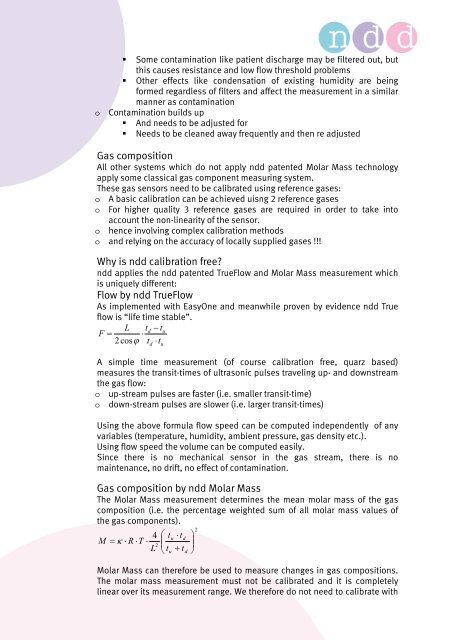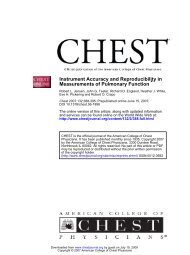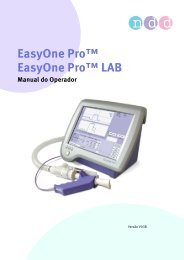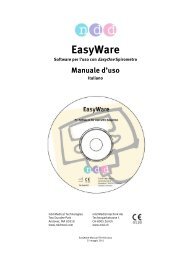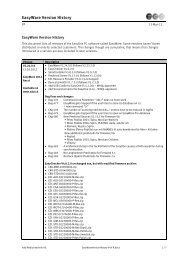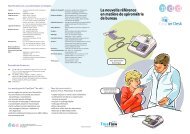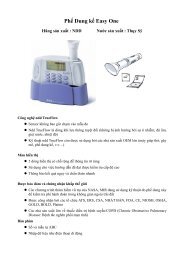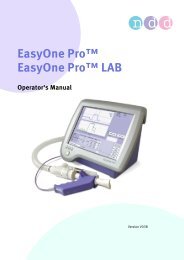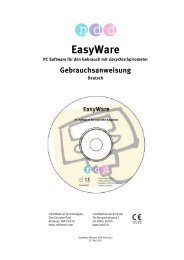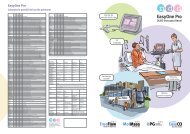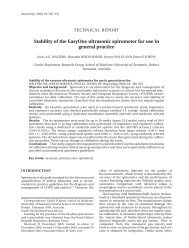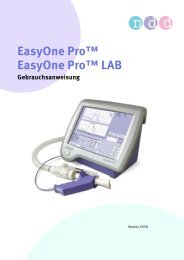Alternative applications of ndd spirette
Alternative applications of ndd spirette
Alternative applications of ndd spirette
Create successful ePaper yourself
Turn your PDF publications into a flip-book with our unique Google optimized e-Paper software.
� Some contamination like patient discharge may be filtered out, but<br />
this causes resistance and low flow threshold problems<br />
� Other effects like condensation <strong>of</strong> existing humidity are being<br />
formed regardless <strong>of</strong> filters and affect the measurement in a similar<br />
manner as contamination<br />
o Contamination builds up<br />
� And needs to be adjusted for<br />
� Needs to be cleaned away frequently and then re adjusted<br />
Gas composition<br />
All other systems which do not apply <strong>ndd</strong> patented Molar Mass technology<br />
apply some classical gas component measuring system.<br />
These gas sensors need to be calibrated using reference gases:<br />
o A basic calibration can be achieved uisng 2 reference gases<br />
o For higher quality 3 reference gases are required in order to take into<br />
account the non-linearity <strong>of</strong> the sensor.<br />
o hence involving complex calibration methods<br />
o and relying on the accuracy <strong>of</strong> locally supplied gases !!!<br />
Why is <strong>ndd</strong> calibration free?<br />
<strong>ndd</strong> applies the <strong>ndd</strong> patented TrueFlow and Molar Mass measurement which<br />
is uniquely different:<br />
Flow by <strong>ndd</strong> TrueFlow<br />
As implemented with EasyOne and meanwhile proven by evidence <strong>ndd</strong> True<br />
flow is “life time stable”.<br />
L td<br />
− tu<br />
F = ⋅<br />
2cosϕ<br />
t ⋅t<br />
d<br />
u<br />
A simple time measurement (<strong>of</strong> course calibration free, quarz based)<br />
measures the transit-times <strong>of</strong> ultrasonic pulses traveling up- and downstream<br />
the gas flow:<br />
o up-stream pulses are faster (i.e. smaller transit-time)<br />
o down-stream pulses are slower (i.e. larger transit-times)<br />
Using the above formula flow speed can be computed independently <strong>of</strong> any<br />
variables (temperature, humidity, ambient pressure, gas density etc.).<br />
Using flow speed the volume can be computed easily.<br />
Since there is no mechanical sensor in the gas stream, there is no<br />
maintenance, no drift, no effect <strong>of</strong> contamination.<br />
Gas composition by <strong>ndd</strong> Molar Mass<br />
The Molar Mass measurement determines the mean molar mass <strong>of</strong> the gas<br />
composition (i.e. the percentage weighted sum <strong>of</strong> all molar mass values <strong>of</strong><br />
the gas components).<br />
4 ⎛ tu<br />
⋅ td<br />
M = κ ⋅ R ⋅T<br />
⋅ 2 ⎜<br />
L ⎝ tu<br />
+ t<br />
d<br />
⎞<br />
⎟<br />
⎠<br />
2<br />
Molar Mass can therefore be used to measure changes in gas compositions.<br />
The molar mass measurement must not be calibrated and it is completely<br />
linear over its measurement range. We therefore do not need to calibrate with


